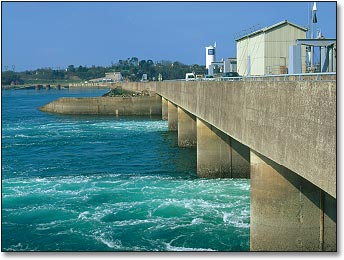-The cost of implementation (if you have a poorer country they might not be able to afford the cost)
-You county's geography (the climate, the size of your country, the location on Earth, the resources available)
-What the government of your country is already doing.
Once you have ranked the energy types, you will explain why you ranked them as you did (based on the above considerations).
-8 marks for each explanation (total /24)
Ranking:
1)Solar
2)Nuclear
3)Tidal
California is a geographically diverse state; some of the major geographic features are: Sierra Nevada, Central Valley and Mojave Desert
Size: 423,970km^2
Climate: from Mediterranean to subartic (depending on latitude, elevation, and proximity to coast)
1)Solar
As previously discussed in Energy Assignment 2: California under the RPS is requiring all utilities in the state to source 33% of their electricity sales from clean renewable sources.
One of them is solar energy. California is encouraging their citizens to implement solar panels within their homes.
"Go Solar California is a joint effort of the California Energy Commission and the California Public Utilities Comission. The goal is to encourage Californians to install 3,000 megawatts of solar energy systems on homes and businesses by the end of 2016, making renewable energy an everyday reality."
Solar price:
The average cost of systems <10 kW is $5.56/watt and $5.06/watt for systems over 10 kW.
I ranked Solar to be their first choice as California is already making plans to further pursue the use of solar panels. Aside from this, the extremely arid areas of California could benefit from the solar panels. The cost of getting solar panels implemented in their homes may be costly, but it would be environmentally benificial and benefit themselves as well. Their electricity would be harnessed from the sun's heat and light; which many areas (and main metroplitan areas) receive much of. Most importantly, it would be a renewable source; a main goal that California is aiming for.
2)Nuclear
"Nuclear power provides reliable base-load power with very low emissions and can offset variability issues incurred by renewables, but faces obstacles with current public policy and public opinion. By law, new nuclear power in California is currently predicated on a solution for nuclear waste." However, "If electric generation is predominantly intermittent renewable power, using natural gas to firm the power would likely result in greenhouse gas emissions that would alone exceed the 2050 target for the entire economy." The CCST prepared its reports for the California Energy Commission.
A kWh costs an average of 12cents in America; a tenth of a cent per gallon. Canyon Diablo nuclear plant in California produces this electricity at only 4cents/kWh
I chose Nuclear to be second despite the benefits stated above due to the fact that Canyon Diablo Power Plant is at risk from two earthquake faults and that MANY Nuclear Power plants in California have already been shut down. In fact, Canyon Diablo is the ONLY nuclear powerplant operational in the state after San Onofre's shutdown in 2013.
3)Tidal
According to a report released this month by the consulting firm Global Data, it's theoretically feasible for California to meet 20% of its energy consumption needs from wave energy. Tidal power off the California coast offers as much as 1,787 terawatt-hours per year of power, about seven times what the state consumes. As the ocean's waves and tidesrise and fall pretty much 24/7 regardless of whether the wind is blowing in the immediate vicinity, that would be base-load power -- allowing us to replace coal- and gas-fired power with renewables without developing fancy storage technology.
There are two big problems. One: the technologies involved are largely unproven and implementing them would be expensive. Two: The ocean along the California shore is important habitat for many kinds of wildlife, and industrializing it will bear certain non-economic costs as well.
I chose Tidal as the third. Tidal energy would be a promising way to create energy that could provide for most of the state's usage and needs but there are too many factors against it. For one, California has already attempted with ocean energy previously with wave energy, but that has shown to be unsuccesful. It could also be economically draining especially if it does not succeed and there's also studies of the technology not being advanced enough but most importantly it will drastically harm the environment.





No comments:
Post a Comment